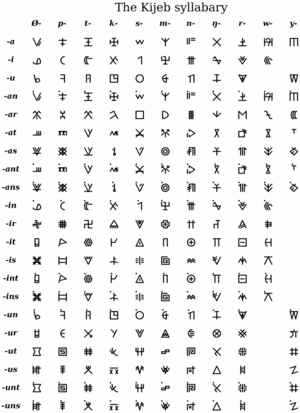Kijeb writing (Sohlob): Difference between revisions
No edit summary |
(Image placement and sizing due to new image version, Unicodification) |
||
| Line 1: | Line 1: | ||
[[Category:Sohlob]] | [[Category:Sohlob]] | ||
[[Image: | [[Image:Kijebsyllabary.gif|thumb|300px|right|The Kijeb syllabary. Click in the image to see it enlarged.]] | ||
[[Kijeb]] is attested in the form of mostly short formal religious, commemorative, dedicative and funerary inscriptions on stone and metal written in a mainly [[Wikipedia:Syllabary|syllabic script]], but with two [[Wikipedia:Logogram|logograms]] used for the words ''*duzba'' "sun" and ''*giwri'' "king", which had special religious and social significance. There is evidence that there existed other writings in Kijeb language and script, since [[Sohlosjan|Sohloçan]] grammarians mention finds of pottery with Kijeb inscriptions in ancient graves. It seems clear however that with few exceptions the preserved Kijeb texts derive from the area where [[Sohlob languages|Kidilib]] was spoken in classical times. | [[Kijeb]] is attested in the form of mostly short formal religious, commemorative, dedicative and funerary inscriptions on stone and metal written in a mainly [[Wikipedia:Syllabary|syllabic script]], but with two [[Wikipedia:Logogram|logograms]] used for the words ''*duzba'' "sun" and ''*giwri'' "king", which had special religious and social significance. There is evidence that there existed other writings in Kijeb language and script, since [[Sohlosjan|Sohloçan]] grammarians mention finds of pottery with Kijeb inscriptions in ancient graves. It seems clear however that with few exceptions the preserved Kijeb texts derive from the area where [[Sohlob languages|Kidilib]] was spoken in classical times. | ||
[[Image:Kijeblogograms.gif|thumb|100px|left|The two logograms used in Kijeb writing]] | |||
The Kijeb syllabary is partly defective in that it ignores the distinction between voiced and voiceless stops, between the stops /p/ and /k/ and their fricative counterparts /f/ and /x/, and in the oldest inscriptions also the distinction between palatalized and unpalatalized consonants, and between velar and labiovelar consonants. Because of these traits it has been argued that the syllabary was originally devised for some other language. | The Kijeb syllabary is partly defective in that it ignores the distinction between voiced and voiceless stops, between the stops /p/ and /k/ and their fricative counterparts /f/ and /x/, and in the oldest inscriptions also the distinction between palatalized and unpalatalized consonants, and between velar and labiovelar consonants. Because of these traits it has been argued that the syllabary was originally devised for some other language. | ||
== The Duzbaximu inscription == | == The Duzbaximu inscription == | ||
{| width=500 | {| width=500 style="clear: right;" | ||
|colspan=2 align=center| [[Image:Duzbaximu.jpg]] | |colspan=2 align=center| [[Image:Duzbaximu.jpg]] | ||
|- | |- | ||
| Line 21: | Line 21: | ||
'''mi-ri-su-na.pan-tin-ta-ru.'''<br> | '''mi-ri-su-na.pan-tin-ta-ru.'''<br> | ||
'''ku-is-ti-u.ki-pa-ta-ti-u.'''<br> | '''ku-is-ti-u.ki-pa-ta-ti-u.'''<br> | ||
'''i-{{IPA| | '''i-{{IPA|ŋ}}u.na-ta-ra-yu.u-{{IPA|ŋ}}u.'''<br> | ||
'''na-ta-ra-si-a.GIWRI.u-ni-ra.'''<br> | '''na-ta-ra-si-a.GIWRI.u-ni-ra.'''<br> | ||
'''ti-a.i-ru.pit-ni-as.ti-'''<br> | '''ti-a.i-ru.pit-ni-as.ti-'''<br> | ||
| Line 33: | Line 33: | ||
''mrisuna, fandintaru:''<br> | ''mrisuna, fandintaru:''<br> | ||
''kwizdyu kibatatyu''<br> | ''kwizdyu kibatatyu''<br> | ||
''i{{IPA| | ''i{{IPA|ŋ}}u natrayu u{{IPA|ŋ}}u''<br> | ||
''natrasya giwri unira-''<br> | ''natrasya giwri unira-''<br> | ||
''dya, iru fidnyas dy-''<br> | ''dya, iru fidnyas dy-''<br> | ||
Revision as of 08:55, 12 January 2007
Kijeb is attested in the form of mostly short formal religious, commemorative, dedicative and funerary inscriptions on stone and metal written in a mainly syllabic script, but with two logograms used for the words *duzba "sun" and *giwri "king", which had special religious and social significance. There is evidence that there existed other writings in Kijeb language and script, since Sohloçan grammarians mention finds of pottery with Kijeb inscriptions in ancient graves. It seems clear however that with few exceptions the preserved Kijeb texts derive from the area where Kidilib was spoken in classical times.
The Kijeb syllabary is partly defective in that it ignores the distinction between voiced and voiceless stops, between the stops /p/ and /k/ and their fricative counterparts /f/ and /x/, and in the oldest inscriptions also the distinction between palatalized and unpalatalized consonants, and between velar and labiovelar consonants. Because of these traits it has been argued that the syllabary was originally devised for some other language.
The Duzbaximu inscription
| File:Duzbaximu.jpg | |
| King Duzbaximu's inscription runs in lines from right to left and from top to bottom. It is given here in transliteration (left) and transcription (right). Go here for a grammatical analysis. | |
|
i-mi-u.ta-ta.GIWRI.DUZBA. |
imyu tata giwri duzba- |

